Thioredoxin-dependent peroxide reductase, mitochondrial is an enzyme that in humans is encoded by the PRDX3 gene. [5] [6] [7] It is a member of the peroxiredoxin family of antioxidant enzymes.
Thioredoxin-dependent peroxide reductase, mitochondrial is an enzyme that in humans is encoded by the PRDX3 gene. [5] [6] [7] It is a member of the peroxiredoxin family of antioxidant enzymes.
This gene encodes a protein with antioxidant function and is localized in the mitochondrion. This gene shows significant nucleotide sequence similarity to the gene coding for the C22 subunit of Salmonella typhimurium alkylhydroperoxide reductase. Expression of this gene product in E. coli deficient in the C22-subunit gene rescued resistance of the bacteria to alkylhydroperoxide. The human and mouse genes are highly conserved, and they map to the regions syntenic between mouse and human chromosomes. Sequence comparisons with recently cloned mammalian homologues suggest that these genes consist of a family that is responsible for regulation of cellular proliferation, differentiation, and antioxidant functions. Two transcript variants encoding two different isoforms have been found for this gene. [7]
It has been demonstrated that serum peroxiredoxin 3 can be a valuable biomarker for the diagnosis and assessment of hepatocellular carcinoma [9] It has been shown that peroxiredoxin proteins protect MCF-7 breast cancer cells against doxorubicin-mediated toxicity. [10] Additionally, it has been shown that peroxiredoxin 3 is overexpressed in prostate cancer and promotes cancer cell survival by defending cells against the damages incurred by oxidative stress. [11]
Thioredoxin reductases are enzymes that reduce thioredoxin (Trx). Two classes of thioredoxin reductase have been identified: one class in bacteria and some eukaryotes and one in animals. In bacteria TrxR also catalyzes the reduction of glutaredoxin like proteins known as NrdH. Both classes are flavoproteins which function as homodimers. Each monomer contains a FAD prosthetic group, a NADPH binding domain, and an active site containing a redox-active disulfide bond.

Thioredoxin is a class of small redox proteins known to be present in all organisms. It plays a role in many important biological processes, including redox signaling. In humans, thioredoxins are encoded by TXN and TXN2 genes. Loss-of-function mutation of either of the two human thioredoxin genes is lethal at the four-cell stage of the developing embryo. Although not entirely understood, thioredoxin is linked to medicine through their response to reactive oxygen species (ROS). In plants, thioredoxins regulate a spectrum of critical functions, ranging from photosynthesis to growth, flowering and the development and germination of seeds. Thioredoxins play a role in cell-to-cell communication.

Glutathione reductase (GR) also known as glutathione-disulfide reductase (GSR) is an enzyme that in humans is encoded by the GSR gene. Glutathione reductase catalyzes the reduction of glutathione disulfide (GSSG) to the sulfhydryl form glutathione (GSH), which is a critical molecule in resisting oxidative stress and maintaining the reducing environment of the cell. Glutathione reductase functions as dimeric disulfide oxidoreductase and utilizes an FAD prosthetic group and NADPH to reduce one molar equivalent of GSSG to two molar equivalents of GSH:

Glutaredoxins are small redox enzymes of approximately one hundred amino-acid residues that use glutathione as a cofactor. In humans this oxidation repair enzyme is also known to participate in many cellular functions, including redox signaling and regulation of glucose metabolism. Glutaredoxins are oxidized by substrates, and reduced non-enzymatically by glutathione. In contrast to thioredoxins, which are reduced by thioredoxin reductase, no oxidoreductase exists that specifically reduces glutaredoxins. Instead, glutaredoxins are reduced by the oxidation of glutathione. Reduced glutathione is then regenerated by glutathione reductase. Together these components compose the glutathione system.
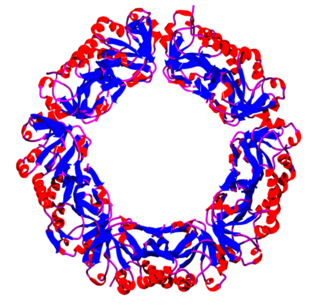
Peroxiredoxins are a ubiquitous family of antioxidant enzymes that also control cytokine-induced peroxide levels and thereby mediate signal transduction in mammalian cells. The family members in humans are PRDX1, PRDX2, PRDX3, PRDX4, PRDX5, and PRDX6. The physiological importance of peroxiredoxins is indicated by their relative abundance. Their function is the reduction of peroxides, specifically hydrogen peroxide, alkyl hydroperoxides, and peroxynitrite.
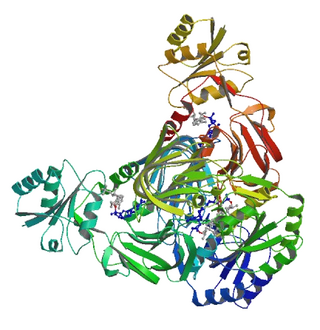
NAD+ kinase (EC 2.7.1.23, NADK) is an enzyme that converts nicotinamide adenine dinucleotide (NAD+) into NADP+ through phosphorylating the NAD+ coenzyme. NADP+ is an essential coenzyme that is reduced to NADPH primarily by the pentose phosphate pathway to provide reducing power in biosynthetic processes such as fatty acid biosynthesis and nucleotide synthesis. The structure of the NADK from the archaean Archaeoglobus fulgidus has been determined.

Nuclear factor erythroid 2-related factor 2 (NRF2), also known as nuclear factor erythroid-derived 2-like 2, is a transcription factor that in humans is encoded by the NFE2L2 gene. NRF2 is a basic leucine zipper (bZIP) protein that may regulate the expression of antioxidant proteins that protect against oxidative damage triggered by injury and inflammation, according to preliminary research. In vitro, NRF2 binds to antioxidant response elements (AREs) in the promoter regions of genes encoding cytoprotective proteins. NRF2 induces the expression of heme oxygenase 1 in vitro leading to an increase in phase II enzymes. NRF2 also inhibits the NLRP3 inflammasome.
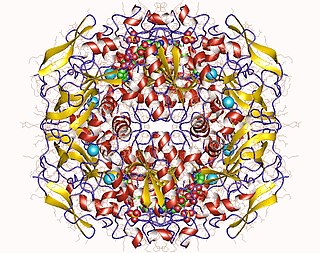
In enzymology, a formaldehyde dehydrogenase (EC 1.2.1.46) is an enzyme that catalyzes the chemical reaction
In enzymology, a sulfiredoxin is an enzyme that catalyzes the chemical reaction

Peroxiredoxin-1 is a protein that in humans is encoded by the PRDX1 gene.

Peroxiredoxin-2 is a protein that in humans is encoded by the PRDX2 gene.

Canalicular multispecific organic anion transporter 2 is a protein that in humans is encoded by the ABCC3 gene.

Peroxiredoxin-6 is a protein that in humans is encoded by the PRDX6 gene. It is a member of the peroxiredoxin family of antioxidant enzymes.
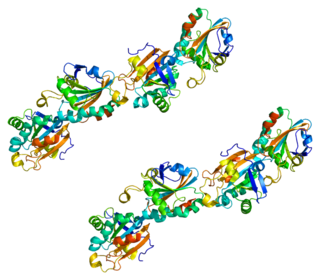
Peroxiredoxin-5 (PRDX5), mitochondrial is a protein that in humans is encoded by the PRDX5 gene, located on chromosome 11.

Carbonyl reductase 1, also known as CBR1, is an enzyme which in humans is encoded by the CBR1 gene. The protein encoded by this gene belongs to the short-chain dehydrogenases/reductases (SDR) family, which function as NADPH-dependent oxidoreductases having wide specificity for carbonyl compounds, such as quinones, prostaglandins, and various xenobiotics. Alternatively spliced transcript variants have been found for this gene.

Glutaredoxin 2 (GLRX2) is an enzyme that in humans encoded by the GLRX2 gene. GLRX2, also known as GRX2, is a glutaredoxin family protein and a thiol-disulfide oxidoreductase that maintains cellular thiol homeostasis. This gene consists of four exons and three introns, spanned 10 kilobase pairs, and localized to chromosome 1q31.2–31.3.

Peptide methionine sulfoxide reductase (Msr) is a family of enzymes that in humans is encoded by the MSRA gene.

Peroxiredoxin-4 is a protein that in humans is encoded by the PRDX4 gene. It is a member of the peroxiredoxin family of antioxidant enzymes.
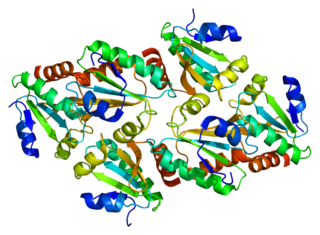
Thioredoxin, mitochondrial also known as thioredoxin-2 is a protein that in humans is encoded by the TXN2 gene on chromosome 22. This nuclear gene encodes a mitochondrial member of the thioredoxin family, a group of small multifunctional redox-active proteins. The encoded protein may play important roles in the regulation of the mitochondrial membrane potential and in protection against oxidant-induced apoptosis.
Thiol oxidoreductases are proteins that redox control by utilizing catalytic cysteine (Cys) residues for oxidation or reduction of their substrates. Examples of such proteins include thioredoxin, thioredoxin reductase, glutathione reductase, glutaredoxin, glutathione peroxidase, and peroxiredoxin.
{{cite book}}: |journal= ignored (help)